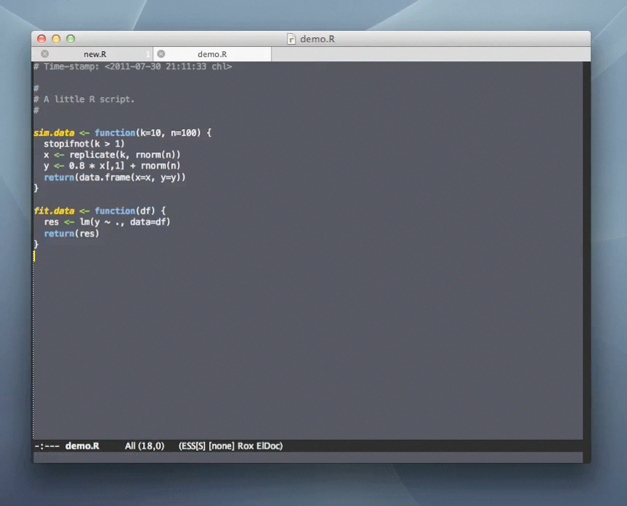
- #EMACS FOR MAC QUICK PDF#
- #EMACS FOR MAC QUICK INSTALL#
- #EMACS FOR MAC QUICK FULL#
) as usual so you don’t accidentally try to execute the ns- prefixed function on e.g. If you have this in your init.el, wrap everything in (when (memq window-system '(mac ns)). If you build Emacs from source, check if the ns-do-applescript function is available at all. Ns-do-applescript returns the script’s string result, if possible, which I also find more straight-forward than creating a temporary background buffer and capturing contents there. This can take a second or two to execute." ( let ( $applescript $result ) Script via: ( setq $applescript "tell application \"Finder\" to if (count of Finder windows) > 0 then get POSIX path of (target of front Finder window as text)" ) ( setq $result ( ns-do-applescript $applescript )) ( if $result ( string-trim $result ) "" ))) The other Chemacs file is the ~/.emacs-profile file where you set the default config to use.( defun ct/finder-path () "Return path of the frontmost Finder window, or the empty string.Īsks Finder for the path using AppleScript via `osascript', so
I use this to set the SPACEMACSDIR variable which tells spacemacs where to look for extra customisation’s. A set of environment variables with env,. this is super useful if you want to exploit emacsclient for a speedy startup, something I am currently working on!. You can set each configuration file to use a different server name with the server-name variable,.  you can change the file name/path by setting the cutom-file variable. Chemacs will load the init.el file from the user-emacs-directory,. "~/.dotfiles/spacemacs-old" ))))) ( "spacemacs-master". "~/.dotfiles/vanilla-emacs" ))) ( "spacemacs-old-m". This is what my ~/.emacs-profiles.el file looks like, Once you have it setup the main functionality comes from two files.įirst there is the ~/.emacs-profiles.el file where you define all of your different configurations. I don’t think I need to repeat the instructions that are listed in their README.
you can change the file name/path by setting the cutom-file variable. Chemacs will load the init.el file from the user-emacs-directory,. "~/.dotfiles/spacemacs-old" ))))) ( "spacemacs-master". "~/.dotfiles/vanilla-emacs" ))) ( "spacemacs-old-m". This is what my ~/.emacs-profiles.el file looks like, Once you have it setup the main functionality comes from two files.įirst there is the ~/.emacs-profiles.el file where you define all of your different configurations. I don’t think I need to repeat the instructions that are listed in their README. #EMACS FOR MAC QUICK INSTALL#
It’s super easy to setup, just clone the repo and run the install script. This is my old spacemacs config running on master.

This is my old (full) spacemacs config running on the develop branch.
#EMACS FOR MAC QUICK FULL#
Although I love spacemacs I am eager to build a full Emacs config from scratch and this config is my attempt. I haven’t decided if I want to fully invest in a literate config file so this is a nice way to experiment. I use tangle/detangle to produce emacs lisp files from the org file. This is the same configuration but written in an Org file with lots of documentation. This is the same config file but running on spacemacs master instead of the develop branch. I want to understand all of the packages I am using and install only the ones I need, thus avoiding a lot of bloat. This is a new config that I am setting up using just spacemacs-base instead of full spacemacs. I am currently running six Emacs configurations, default page width behavior ( setq-default pdf-view-display-size 'fit-page ) ChemacsĬhemacs is an Emacs profile switcher that makes it easy to run multiple Emacs configs side by side. I think I read somewhere that it might interfere with tiling window managers as well and we can’t be having that, so let’s install it without, I personally don’t like having a title bar on my beautiful editor so I choose not to install it. In particular, it provides a lot of native GUI support. This is an excellent blog post detailing how The Emacs Mac Port (which I installed using Homebrew from this repo) greatly improves Emacs’ functionality with MacOS. Many GitHub issues later and The Emacs Mac Port came to the rescue. #EMACS FOR MAC QUICK PDF#
So I set out on a second mission to get my myself a high res pdf viewing experience within Emacs. Unfortunately, both of these installs don’t support retina pdf quality in PDFView (pdf-tools). I use the pdf-tools package through the pdf-tools spacemacs layer for viewing all my pdfs writing LaTeX docs (using org-mode and/or auctex), reading books, reading papers (using org-ref) etc. I stumbled across Emacs-plus which solved the issue but left me with another…

This really started to bug me so I invested a hefty chunk of time (in classic Emacs style) to find a solution. emacs from homebrew) are not recognised by the yabai tiling window manager and don’t tile properly. I wanted to write the post because I have been on a roller coaster getting an Emacs install that provides all of the functionality that I want (maybe even need!). This is a short post detailing how I installed Emacs and configured an environment for maintaining multiple configurations (on my MacBook Pro).







 0 kommentar(er)
0 kommentar(er)
